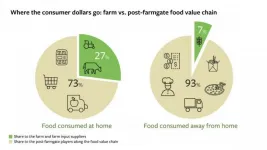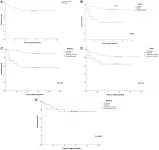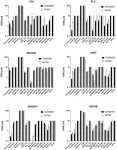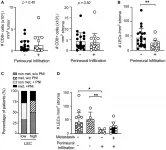(Press-News.org) CAMBRIDGE, MA -- About 60 percent of drugs on the market have hydrophobic molecules as their active ingredients. These drugs, which are not soluble in water, can be difficult to formulate into tablets because they need to be broken down into very small crystals in order to be absorbed by the human body.
A team of MIT chemical engineers has now devised a simpler process for incorporating hydrophobic drugs into tablets or other drug formulations such as capsules and thin films. Their technique, which involves creating an emulsion of the drug and then crystallizing it, allows for a more powerful dose to be loaded per tablet.
"This is very important because if we can achieve high drug loading, it means that we can make smaller dosages that still achieve the same therapeutic effect. This can greatly improve patient compliance because they just need to take a very small drug and it's still very effective," says Liang-Hsun Chen, an MIT graduate student and the lead author of the new study.
Patrick Doyle, the Robert T. Haslam Professor of Chemical Engineering, is the senior author of the paper, which appears today in Advanced Materials.
Nanoemulsions
Most medicines consist of an active ingredient that is combined with other compounds called excipients, which help to stabilize the drug and control how it is released in the body. The resulting tablets, capsules, or films are called formulations.
Currently, to create formulations of hydrophobic drugs, pharmaceutical companies use a process that requires milling the compound down to nanocrystals, which are easier for human cells to absorb. These crystals are then blended with excipients. One excipient that is often mixed with hydrophobic drugs is methylcellulose, a compound derived from cellulose. Methylcellulose dissolves easily in water, which helps drugs to be released faster in the body.
This method is widely used, but has many inefficiencies, according to the MIT team. "The milling step is very time consuming and energy intensive, and the abrasive process can cause changes in active ingredient properties, which can undermine the therapeutic effects," Chen says.
He and Doyle set out to come up with a more efficient way to combine hydrophobic drugs with methylcellulose, by forming an emulsion. Emulsions are mixtures of oil droplets suspended in water, such as the mixture formed when an oil and vinegar salad dressing is shaken up.
When these droplets are on the scale of nanometers in diameter, this kind of mixture is called a nanoemulsion. To create their nanoemulsion, the researchers took a hydrophobic drug called fenofibrate, which is used to help lower cholesterol, and dissolved it in an oil called anisole. Then they combined this oil phase with methylcellulose dissolved in water, using ultrasonication (sound waves) to create nanoscale oil droplets. Methylcellulose helps to keep the water and oil droplets from separating again because it is amphiphilic, meaning that it can bind to both the oil droplets and the water.
Once the emulsion is formed, the researchers can transform it into a gel by dripping the liquid into a heated water bath. As each drop hits the water, it solidifies within milliseconds. The researchers can control the size of the particles by changing the size of tip that is used to drip the liquid into the water bath.
"The particle formation is nearly instantaneous, so everything that was in your liquid drop gets converted to a solid particle without any loss," Doyle says. "After drying, we have nanocrystals of fenofibrate uniformly distributed in the methylcellulose matrix."
Smaller pills, more drug
Once the nanocrystal-loaded particles are formed, they can be crushed into powder and then compressed into tablets, using standard drug manufacturing techniques. Alternatively, the researchers can pour their gel into molds instead of dripping it into water, allowing them to create drug tablets in any shape.
Using their nanoemulsion technique, the researchers were able to achieve drug loading of about 60 percent. In contrast, the currently available formulations of fenofibrate have a drug concentration of about 25 percent. The technique could be easily adapted to load even higher concentrations by increasing the ratio of oil to water in the emulsion, the researchers say.
"This can enable us to make more effective and smaller drugs that are easier to swallow, and that can be very beneficial for many people who have difficulty swallowing drugs," Chen says.
This method can also be used to make thin films -- a type of drug formulation that has become more widely used in recent years, and is especially beneficial for children and older people. Once a nanoemulsion is made, the researchers can dry it into a thin film that has drug nanocrystals embedded in it.
It is estimated that about 90 percent of the drugs now in development are hydrophobic, so this approach could potentially be used to develop formulations for those drugs, as well as hydrophobic drugs that are already in use, the researchers say. Many widely used drugs, including ibuprofen and other anti-inflammatory drugs such as ketoprofen and naproxen, are hydrophobic.
"The flexibility of the system is that we can choose different oils to load different drugs, and then make it into a nanoemulsion using our system. We don't need to do a lot of trial-and-error optimization because the emulsification process is the same," Chen says.
INFORMATION:
The research was funded by the National Science Foundation, the Singapore National Research Foundation, and the Think Global Education Trust.
ITHACA, N.Y. - As soon as an ear of corn is taken off its stalk or a potato is pulled from the ground, it travels anywhere from a few miles to across continents and sometimes undergoes processes that transform it into the food we consume.
These miles and processes contribute to what's known as the food value chain (FVC), along which, as one might expect, the value of the product increases. However, most of the research and attention thus far paid to FVCs occurs at the ends of the chain - inside the farm gate and at the consumer's plate.
Less is understood about all of the other links in the FVC, in part due to a lack of ...
Oncotarget published "Landscape of somatic mutations in breast cancer: new opportunities for targeted therapies in Saudi Arabian patients" which reported that the association between genetic polymorphisms in tumor suppressor genes and the risk of BCa has been studied in many ethnic populations with conflicting conclusions while Arab females and Saudi Arabian studies are still lacking.
The authors screened a cohort of Saudi BCa patients by NGS using a bespoke gene panel to clarify the genetic landscape of this population, correlating and assessing genetic ...
In the quest for healthy aging and longer lifespan, Danish researchers at the University of Southern Denmark have collaborated with Swedish researchers at Karolinska Institutet to explore the anti-aging effects of football and team handball training in women.
In a current study published in Scientific Reports, the researchers investigated the effects of lifelong regular exercise on two of the central hallmarks of aging combined and showed that football and team handball have a positive effect on telomere length and mitochondrial function in women.
"Our legacy consists of DNA that is packed in chromosomes. When cells divide, the inheritance is copied, but with each cell division the ends of the DNA threads get shorter. The so-called telomeres are shortened, which causes us to age. ...
High blood pressure, or hypertension, is the leading modifiable risk factor for cardiovascular diseases and premature death worldwide. And key to treating patients with conditions ranging from chest pain to stroke is understanding the intricacies of how the cells around arteries and other blood vessels work to control blood pressure. While the importance of metals like potassium and calcium in this process are known, a new discovery about a critical and underappreciated role of another metal - zinc - offers a potential new pathway for therapies to treat hypertension.
The study results were published recently in Nature Communications.
All the body's functions depend on arteries channeling oxygen-rich ...
The COVID-19 pandemic continues to disrupt and end lives around the world, and public health officials worldwide have recognized vaccines as the critical tools required for controlling the COVID-19 death toll and achieving a return to normal life. Several vaccines against COVID-19 are already in use, but the limited supplies of these vaccines and the possibility of safety and efficacy issues of the existing vaccines mean that it is important for scientists to develop more (and even better) vaccines. In fact, as of February 2021, 69 different vaccines are in various phases of clinical development.
One type of vaccine that could prove quite useful is the inactivated vaccine, which contains an inactivated form of the virus. The inactivated virus cannot harm the recipient, but ...
A new study published in the journal Diversity and Distributions predicts massive range declines of Africa's great apes - gorillas, chimpanzees and bonobos - due to the impacts of climate change, land-use changes and human population growth.
For their analysis, the authors compiled information on African ape occurrence held in the IUCN SSC A.P.E.S. database, a repository that includes a remarkable amount of information on population status, threats and conservation for several hundred sites, collected over 20 years.
The first-of-its-kind study quantifies the joint effects of climate, land-use, and human population changes across African ape ranges for the year ...
Oncotarget published "Effect of cell microenvironment on the drug sensitivity of hepatocellular cancer cells" which reported that this study aimed to investigate whether Hepatocellular Cancer (HCC) cells cultured in more native conditions have an altered phenotype and drug sensitivity compared to those cultured in standard conditions.
Six HCC cell lines were cultured in "standard" or more "native" conditions.
HCC cells cultured in native conditions had slower doubling times, increased HK2 and GLUT, lower PHDA and ATP levels, and mutations in mitochondrial DNA.
From 90 comparisons of drug sensitivity, increased resistance ...
Oncotarget published "Mutually exclusive lymphangiogenesis or perineural infiltration in human skin squamous-cell carcinoma" which reported that although tumor-associated lymphangiogenesis correlates with metastasis and poor prognosis in several cancers, it also supports T cell infiltration into the tumor and predicts favorable outcome to immunotherapy.
Using quantitative multiplex immunohistochemistry, the authors analyzed skin squamous-cell carcinoma (sSCC) sections from 36 patients.
CD8 T cell infiltration showed great differences between patients, whereby these ...
ADELPHI, Md. -- Army researchers developed a pioneering framework that provides a baseline for the development of collaborative multi-agent systems.
The framework is detailed in the survey paper Survey of recent multi-agent reinforcement learning algorithms utilizing centralized training, which is featured in the SPIE Digital Library. Researchers said the work will support research in reinforcement learning approaches for developing collaborative multi-agent systems such as teams of robots that could work side-by-side with future Soldiers.
"We propose that the underlying information sharing mechanism plays a critical role in centralized learning for multi-agent systems, ...
WASHINGTON -- For more than 25 years, Burmese pythons have been living and breeding in the Florida Everglades where they prey on native wildlife and disrupt the region's delicate ecosystems. A new study shows that infrared cameras could make it easier to spot these invasive snakes in the Florida foliage, providing a new tool in the effort to remove them.
In the Optical Society (OSA) journal Applied Optics, researchers led by Dr. Kyle Renshaw from the University of Central Florida College of Optics and Photonics report that a near infrared camera helped people detect Burmese pythons at distances up to 1.3 times farther away than was possible using a traditional visible-wavelength ...








